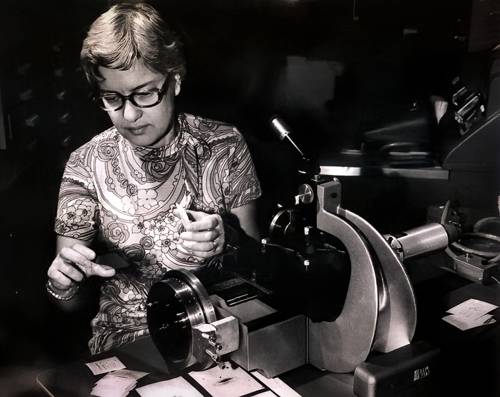
FAQ About Vera Rubin

Who was Vera Rubin?
Vera Rubin was an influential American astronomer born on July 23, 1928. She is best known for her groundbreaking work on galaxy rotation rates, which provided crucial evidence for the existence of dark matter in the universe. Rubin's research significantly altered the understanding of how galaxies and the universe itself are structured and formed.

What is Vera Rubin best known for?
Vera Rubin is best known for her pioneering work on the rotation curves of galaxies. Her observations and analysis provided convincing evidence for the existence of dark matter, a form of matter that does not emit light or energy, making it invisible and detectable only through its gravitational effects.

How did Vera Rubin contribute to the discovery of dark matter?
Vera Rubin, along with her collaborator Kent Ford, studied the rotational velocities of galaxies and found that the outer regions were rotating at much faster speeds than expected. According to Newtonian physics, these speeds required an unseen mass, leading to the conclusion that much of the galaxy's mass was invisible, or dark matter. Her work was instrumental in confirming the presence of dark matter in the universe.

Where did Vera Rubin conduct her research?
Vera Rubin conducted much of her research at the Carnegie Institution of Washington's Department of Terrestrial Magnetism. The telescopic observations critical to her discoveries were performed at various observatories, including the Lowell Observatory in Arizona.

What awards did Vera Rubin receive for her work?
Throughout her career, Vera Rubin received numerous prestigious awards, including the National Medal of Science in 1993 and the Gold Medal of the Royal Astronomical Society in 1996. Despite her groundbreaking contributions, she was notably never awarded a Nobel Prize, a point often cited in discussions about gender inequality in science.

What impact did Vera Rubin's findings have on astronomy?
Vera Rubin's findings fundamentally changed the field of astronomy by providing strong evidence for dark matter, thereby reshaping our understanding of the universe's composition and structure. Her work laid the foundation for numerous subsequent studies that confirmed and expanded upon the concept of dark matter, influencing both theoretical and observational astrophysics.

Did Vera Rubin face any challenges in her career?
Yes, Vera Rubin faced significant challenges, particularly as a woman pursuing a career in astronomy during the mid-20th century. She encountered gender-based biases and often had to work harder to gain access to research positions and observatories. Despite these barriers, she persevered and became a leading figure in her field.

What is dark matter, the concept Vera Rubin helped to illuminate?
Dark matter is a form of matter that does not interact with electromagnetic forces, meaning it does not absorb, reflect, or emit light, making it invisible and detectable only through its gravitational effects on visible matter, radiation, and the large-scale structure of the universe. Rubin's work provided some of the first compelling evidence for its existence by observing how galaxies rotate.

When did Vera Rubin make her significant discovery about galaxy rotations?
Vera Rubin's significant observations on galaxy rotations were primarily conducted in the 1970s. It was through these studies that she noted the discrepancy between the expected and observed rotational velocities of galaxies, leading to the conclusion that a substantial amount of unseen mass was present—dark matter.

Why is Vera Rubin's work considered a major milestone in astronomy?
Vera Rubin's work is considered a major milestone in astronomy because it provided concrete evidence for dark matter, an essential component thought to make up about 27% of the universe. Her observations challenged existing models of galaxy formation and dynamics, prompting new theories and extensive research into the unseen mass that holds galaxies together.

What educational background did Vera Rubin have?
Vera Rubin earned a bachelor's degree in astronomy from Vassar College in 1948, a master's degree from Cornell University in 1951, and a Ph.D. in astronomy from Georgetown University in 1954. Her academic journey was marked by her determination to succeed in a field that was not always welcoming to women.

What was unique about Vera Rubin's approach to studying galaxies?
Vera Rubin's unique approach involved focusing on the rotation curves of over 60 spiral galaxies, using spectrographic data to analyze how the rotational velocity varied with distance from the galactic center. Her meticulous and systematic observations revealed consistent anomalies that indicated the presence of dark matter, challenging previously accepted notions in astronomy.

How has Vera Rubin influenced future generations of astronomers?
Vera Rubin has greatly influenced future generations of astronomers by breaking barriers for women in science and by re-shaping the field with her discoveries. Her persistent advocacy for observational astronomy and her role as a mentor inspired many young astronomers to pursue careers in the sciences, and her work remains a key part of the astronomical curriculum worldwide.

Was Vera Rubin's work widely accepted at the time of her findings?
Initially, Vera Rubin's findings met some skepticism, as they challenged existing theories of galaxy dynamics and mass distribution. However, over time, as more observations confirmed her results, her work became widely accepted as foundational evidence for the presence of dark matter in the universe.

What was Vera Rubin's role in the scientific community beyond her research?
Beyond her research, Vera Rubin was an advocate for women in science and an active participant in promoting gender equality and diversity within the field of astronomy. She frequently spoke out against the biases women faced in academia and was involved in mentoring aspiring female scientists throughout her career.

Are there any institutions or awards named after Vera Rubin?
Yes, the Vera C. Rubin Observatory, previously known as the Large Synoptic Survey Telescope, was named in her honor. This observatory, located in Chile, is designed to conduct a 10-year survey of the universe, contributing significantly to research in dark matter, among other astronomical topics.

What was the most notable publication by Vera Rubin?
One of Vera Rubin's most notable publications was her landmark paper on the rotational velocities of spiral galaxies, co-authored with Kent Ford in 1978. Titled "Rotation of the Andromeda Nebula from a Spectroscopic Survey of Emission Regions," this work provided significant evidence for dark matter.

Did Vera Rubin collaborate with other scientists on her research?
Yes, Vera Rubin collaborated with several scientists throughout her career. Notably, her work on galaxy rotation curves was carried out in collaboration with astronomer Kent Ford, who designed and built the instruments used to record the spectrographic data essential for their groundbreaking research.

How did Vera Rubin's early life influence her career choice?
Vera Rubin showed interest in astronomy from a young age. Encouraged by her father, she would watch the stars from their home in Washington D.C. Her early passion for the night sky, combined with her determination to pursue science despite societal challenges, led her to become one of the most influential astronomers of her time.

What legacy did Vera Rubin leave behind in the field of astronomy?
Vera Rubin left behind a profound legacy that includes her pivotal contributions to the discovery of dark matter, the inspiration she provided to countless female scientists, and her advocacy for diversity in science. Her work helped cement the importance of dark matter in astrophysics, making her a revered figure whose influence continues to resonate in scientific circles today.
